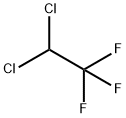
2,2-ДИХЛОРО-1,1,1-ТРИФТОРЭТАН
- английское имя1,1-Dichloro-2,2,2-trifluoroethane
- CAS №306-83-2
- CBNumberCB5777280
- ФормулаC2HCl2F3
- мольный вес152.93
- EINECS206-190-3
- номер MDLMFCD00042132
- файл Mol306-83-2.mol
| Температура плавления | -107°C |
| Температура кипения | 27.6°C |
| плотность | 1,475 g/cm3 |
| давление пара | 93.456kPa at 25.62℃ |
| показатель преломления | 1.3290 |
| Fp | 9℃ |
| температура хранения | 2-8°C |
| форма | A liquid |
| Растворимость в воде | 2.1g/L at 25℃ |
| LogP | 2.17 at 20℃ |
| Справочник по базе данных CAS | 306-83-2(CAS DataBase Reference) |
| FDA UNII | 6S7C791U3V |
| Справочник по химии NIST | Ethane, 2,2-dichloro-1,1,1-trifluoro-(306-83-2) |
| Система регистрации веществ EPA | HCFC-123 (306-83-2) |
| Коды опасности | T,Xi,N | |||||||||
| Заявления о рисках | 23/24/25-39-39/23/24/25-59 | |||||||||
| Заявления о безопасности | 36/37-45-59 | |||||||||
| РИДАДР | 3163 | |||||||||
| WGK Германия | 1 | |||||||||
| Примечание об опасности | Irritant | |||||||||
| TSCA | T | |||||||||
| Класс опасности | IRRITANT, GAS, OZONE DEPLETER | |||||||||
| Банк данных об опасных веществах | 306-83-2(Hazardous Substances Data) | |||||||||
| Токсичность | LD50 skin in rabbit: > 2gm/kg | |||||||||
| NFPA 704: |
|
рисовальное письмо(GHS)
-
рисовальное письмо(GHS)



-
сигнальный язык
опасность
-
вредная бумага
H301+H311+H331:Токсично при проглатывании, при контакте с кожей или при вдыхании.
H225:Легковоспламеняющаяся жидкость. Пары образуют с воздухом взрывоопасные смеси.
H420:Разрушает озоновый слой.
H370:Поражает органы (Глаза) в результате однократного воздействия.
-
оператор предупредительных мер
P210:Беречь от тепла, горячих поверхностей, искр, открытого огня и других источников воспламенения. Не курить.
P260:Не вдыхать газ/ пары/ пыль/ аэрозоли/ дым/ туман.
P280:Использовать перчатки/ средства защиты глаз/ лица.
P301+P310:ПРИ ПРОГЛАТЫВАНИИ: Немедленно обратиться за медицинской помощью. Прополоскать рот.
P311:Обратиться за медицинской помощью.
2,2-ДИХЛОРО-1,1,1-ТРИФТОРЭТАН химические свойства, назначение, производство
Химические свойства
1,1-Dichloro-2,2,2-trifluoroethane has a light ethereal odor with poor warning properties.Использование
HCFC 123 is an interim replacement for the CFCs and is scheduled for a production phase-out during the 2020s. Its main application is as a substitute for CFC 11 in centrifugal chillers used for air conditioning of large buildings. It is also used in smaller air-conditioning units, and may have applications in foam blowing, and firefighting and as a chemical intermediate.Общее описание
Colorless nonflammable gas. Nearly odorless.Профиль реактивности
1,1-Dichloro-2,2,2-trifluoroethane is chemically inert in many situations, but can react violently with strong reducing agents such as the very active metals and the active metals. They suffer oxidation with strong oxidizing agents and under extremes of temperature.Угроза здоровью
HCFC-123 (2,2-dichloro-1,1,1-trifluoroethane) has evidenced significant human liver toxicity. A group of 17 workers suffered liver damage in a 1997 outbreak. They were involved in containerizing this liquid. HCFC-123 is chemically similar to halothane and has the same toxic metabolite. HCFC- 123 exposure also was implicated as the cause of liver disease in nine industrial workers who had repeated exposure because of a leaking airconditioning system in 1996; the refrigerant also contained HCFC-124. HCFC-124 and HCFC-125 are also structurally similar to halothane.Профиль безопасности
Suspected carcinogen. Moderately toxic by inhalation. When heated to decomposition it emits very toxic fumes of Fand Cl-. See also CHLORINATED HYDROCARBONS, ALIPHATIC; and FLUORIDES.Канцерогенность
An inhalation toxicity/oncogenicity study was conducted with groups of 80 male and 80 female rats. This study was described earlier in this section. In addition to the effects on serum chemistry parameters and the retina, increases in benign tumors of the pancreas, testes, and liver were reported. As noted above, the survival in the HCFC 123–exposed animals was better than in the airexposed controls. These tumors tended to appear near the end of the study and generally were not considered to be the cause of death.2,2-ДИХЛОРО-1,1,1-ТРИФТОРЭТАН запасные части и сырье
запасной предмет